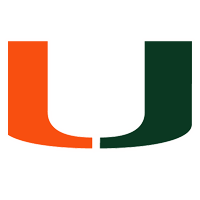GojiraCane
All ACC
- Joined
- Dec 31, 2018
- Messages
- 7,690
Factoring in our ten recent signings (including the Lichtensein transfer) as well as departing players, I currently show the Miami Hurricanes with 82 scholarship players:

*247 Sports rankings
For outgoing players, I presently have eighteen players as having played their final games at Miami this season.

Of blue chip composition of the current roster, the Hurricanes now rise to 57%. This is higher than last season (albeit with a smaller roster), and the best that it has been since at least 2006 or earlier. For comparison, the low-water mark for Miami was 26% in 2012. As recently as 2017, the blue chip ratio was at 35%.
Of these blue chip players, almost half (49%) are first or second year players. I am not counting transfers in this equation.

Why does this matter? Well, all season we kept hearing about the young freshmen who were playing. Maintaining a healthy dispersal of talent across all four classes is key to a balanced program. We have had situations in the past where that ratio was out of skew - most notably in 2011 when only 27% of Miami's thirty blue chip players were in their first and second years. That puts the coach in the position where they absolutely have to nail a Top 10 class just to keep their overall blue chip ratio healthy. Any hiccup and the overall roster strength will fall, as it did the following year when Miami dropped to just 21 blue chip players despite the fact that Golden had landed nine four or five star players that year.
While the 2022 class remains incomplete, here is where we stand compared to previous years:

It's interesting to note that since Mark Richt arrived in 2016 only two players failed to qualify or left before their first season began. Prior to that, Miami averaged at least one between 2008 and 2014. Three years (2010, 2011, and 2013) we had three players that signed who never played a down.
Finally, we come to overall roster composition:

Although safeties and corners are grouped together here, we remain low in the latter.
*247 Sports rankings
For outgoing players, I presently have eighteen players as having played their final games at Miami this season.
Of blue chip composition of the current roster, the Hurricanes now rise to 57%. This is higher than last season (albeit with a smaller roster), and the best that it has been since at least 2006 or earlier. For comparison, the low-water mark for Miami was 26% in 2012. As recently as 2017, the blue chip ratio was at 35%.
Of these blue chip players, almost half (49%) are first or second year players. I am not counting transfers in this equation.
Why does this matter? Well, all season we kept hearing about the young freshmen who were playing. Maintaining a healthy dispersal of talent across all four classes is key to a balanced program. We have had situations in the past where that ratio was out of skew - most notably in 2011 when only 27% of Miami's thirty blue chip players were in their first and second years. That puts the coach in the position where they absolutely have to nail a Top 10 class just to keep their overall blue chip ratio healthy. Any hiccup and the overall roster strength will fall, as it did the following year when Miami dropped to just 21 blue chip players despite the fact that Golden had landed nine four or five star players that year.
While the 2022 class remains incomplete, here is where we stand compared to previous years:
It's interesting to note that since Mark Richt arrived in 2016 only two players failed to qualify or left before their first season began. Prior to that, Miami averaged at least one between 2008 and 2014. Three years (2010, 2011, and 2013) we had three players that signed who never played a down.
Finally, we come to overall roster composition:
Although safeties and corners are grouped together here, we remain low in the latter.

